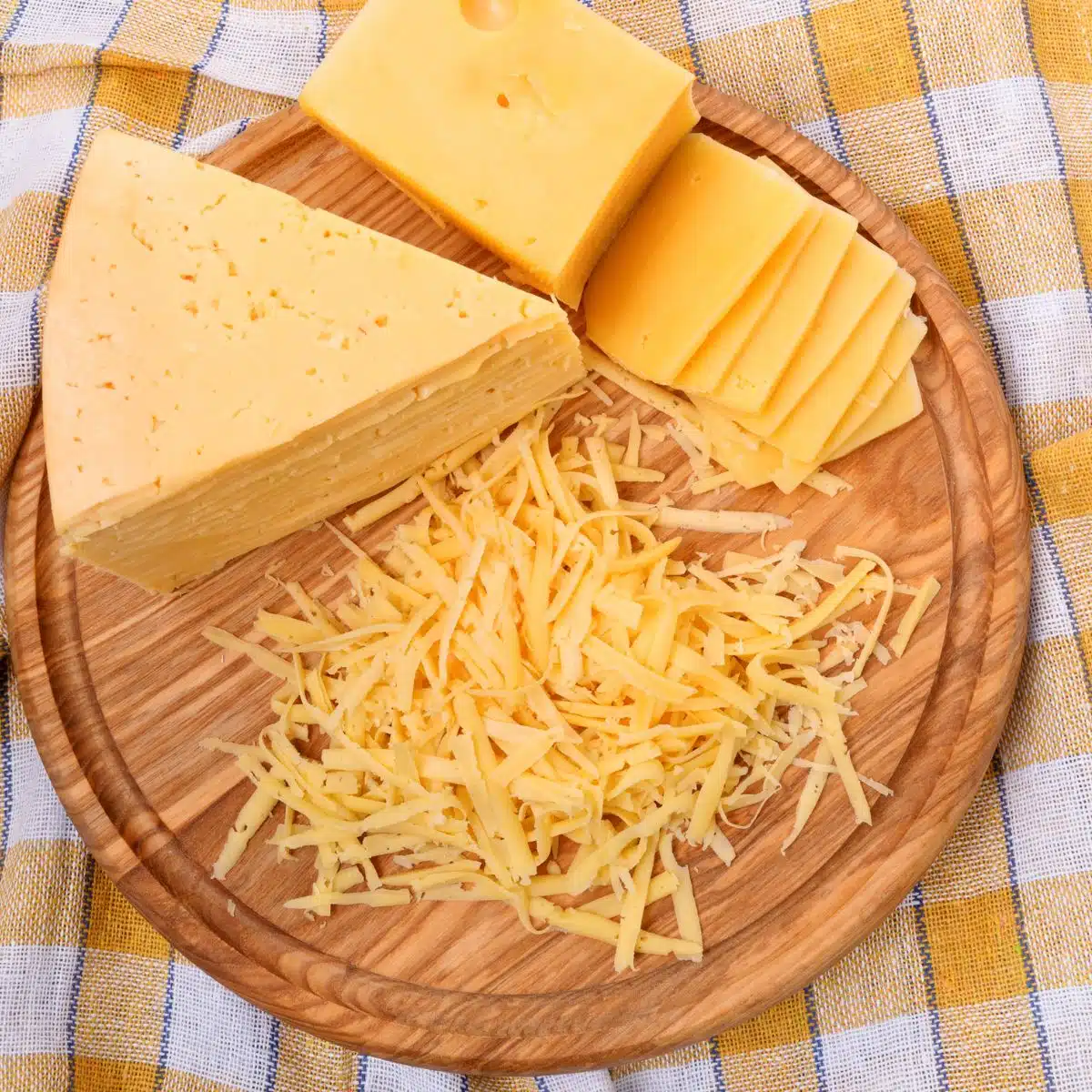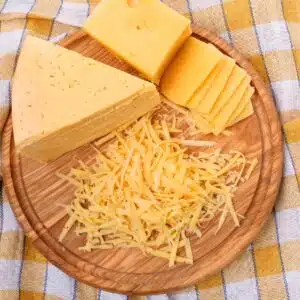The best cheese for pasta is one that satisfies personal taste as well as complements the other ingredients of the dish. But some pasta does pair better with certain types of cheese. In this article, I will show you the best varieties of cheese to choose from for any pasta dish!
Pick The Best Cheese To Add To Your Pasta Dishes
When looking for the best pasta cheese for your dish, it is important to consider how you want to use the cheese. For example, feta is better for thickening sauces or adding flavor to lighter pasta dishes because it warms rather than melts.

Jump to:
Hard cheeses like Parmesan and Pecorino Romano are excellent choices for grating or shaving to finish a dish. Softer cheese like mozzarella is an excellent choice for melting because it gives you that delightfully gooey, stringy texture.
Here are some cheeses that I think are the best choices for pasta!
1. Parmesan
Parmesan is the most classic choice for pasta dishes. In Italy, it is called Parmigiano-Reggiano. It is a hard cheese with a nutty, slightly salty flavor.
Typically, this cheese is used for grating to finish a dish, but it can be melted if cut into thin slices (though it might need longer to cook).
2. Gorgonzola
If you want to add a level of bitterness to your pasta bake, Gorgonzola is your best choice! It's a soft Italian blue cheese with a mild yet zingy flavor that works well in both white and red pasta sauces.
Gorgonzola is also used to make four-cheese sauce, adding deeper flavor to pasta bakes.
3. Asiago
Like Parmesan, Asiago has a delightful nutty undertone and can be grated or crumbled. It works well with most pasta dishes and is super creamy when melted (note: it does not fully melt), but needs to be heated gently.
Fresh Asiago is semi-hard and gets harder as it ages.
4. Havarti
Originating from Denmark, Havarti cheese is creamy, buttery, a little acidic, and somewhat sweet. Because of its milder flavor (like Monterey Jack), it works very well in dishes that have bolder flavors.
Substitute cheddar with Havarti for a gooier Mac and Cheese, or make a sauce for pasta bake!
>>>>See all of my recipes here<<<<
5. Ricotta
Ricotta is a thick and creamy Italian cheese made from the leftover whey of goat or cow milk. It melts very well, so it is great for thickening sauces and is a favorite ingredient for lasagna or other pasta bakes and casseroles.
It is also typically used to fill the inside of cheese-stuffed pasta shells.
6. Cheddar
Cheddar was invented in England and is very popular in the U.S. It goes great with spaghetti, macaroni and cheese, or a four-cheese pasta bake. The more aged the cheddar block is, the sharper its flavor will be.
Fresh cheddar (aged less than a month) has a sweeter flavor.
7. Mozzarella
A soft, mild Italian cheese, mozzarella is made from cow's milk (authentic mozzarella from buffalo milk). It is kept fresh by being stored in brine.
It can be used on spaghetti but works better in lasagna and other pasta dishes that call for a creamy base. This cheese is also one of the main ingredients in a four-cheese sauce.
8. Pecorino Romano
Made from sheep's milk, this hard Italian cheese has a flaky texture and is very crumbly. It is not a melting cheese and works best grated over pasta dishes and then drizzled with balsamic vinegar (this is optional).
One of Italy's oldest cheeses, it has salty, sharp, smoky, and spicy flavor notes.
What Are Good Melting Cheeses For Pasta
Good melting cheeses for pasta are typically soft and creamy, giving you a gooey, stretchy texture (with no lumps) when melted. These cheeses include mozzarella, ricotta, havarti, gorgonzola, and provolone.
Provolone is a versatile cheese and works well for any pasta dish or casserole recipe. It is also an excellent substitute for mozzarella or a flavor-packed addition!
What Is The Best Cheese For Red Pasta
Goat cheese is typically used with red pasta. The soft texture of goat cheese (feta) makes it a wonderful choice to finish your dish or even thicken the sauce as it warms into a thick, creamy texture rather than completely melting.
But you can use any cheese you like. Parmesan, Asiago, cheddar, and gorgonzola are great choices, too!
Which Mozzarella Cheese Is Best For Pasta
The best mozzarella cheese for pasta is low-moisture mozzarella. It has a denser texture and stronger flavor than mozzarella packaged in brine.
The most common form of low-moisture mozzarella is pre-shredded and can be found in the grocery store's dairy section.
Now that you have a list of my favorite cheeses to pair with any pasta sauce or recipe, you're all set to make a great meal! Let me know your favorites in the comments!
Do you love a recipe you tried? Please leave a 5-star 🌟rating in the recipe card below and/or a review in the comments section further down the page.
Stay in touch with me through social media @ Pinterest, Facebook, Instagram, or Twitter! Subscribe to the newsletter today (no spam, I promise)! Don't forget to tag me when you try one of my recipes!
📖 Recipe Card
Best Cheese For Pasta: Spaghetti Bolognese (A Complete Guide To Pairing Cheese For Pasta Dishes)
Ingredients
- 1 ½ tablespoon olive oil (extra virgin)
- 2 teaspoon garlic (minced)
- 1 large onion (white or yellow onion, finely diced)
- 1 large carrot (washed and grated)
- 2 ribs celery (finely diced)
- 1 lb ground beef (or a combo of half ground beef & half ground pork)
- ½ cup dry red wine (I like cabernet sauvignon, pinot noir, and malbec)
- 2 beef bouillon cubes (or 2 teaspoons Better Than Bouillon beef base)
- 28 oz crushed tomatoes
- 2 tablespoon tomato paste
- 2 teaspoon Worcestershire sauce
- 2 large bay leaves
- 1 teaspoon dried oregano
- 1 teaspoon dried basil
- each, salt & pepper (to taste)
- 12 oz spaghetti pasta (dried)
(Note: 2x or 3x only changes the ingredient list)
Instructions
- Heat a deep skillet, pot, or Dutch oven with the olive oil over medium-high heat until the oil begins to shimmer. Add the minced garlic, diced onion, grated carrot, and finely diced celery (sofrito!) and saute for 3 minutes or until softened and fragrant.
- Add the ground beef (or ground pork combo) to the skillet and brown. Break up the ground meat as you cook it until it is fully cooked, about 6 minutes.
- Once the beef has been browned add the red wine to deglaze the pan and bring it to a simmer. Cook for 1 minute as you scrape the bottom of the pot clean of any debris. *The alcohol smell should be cooked off by this time.
- Add most of the remaining ingredients (beef bouillon cubes or Better Than Bouillon, crushed tomatoes, tomato paste, Worcestershire sauce, bay leaves, thyme, and oregano).
- Stir to mix and bring the pot back to a simmer. Reduce to medium-low and simmer for 20-30 minutes without a lid. Watch the sauce and add water as needed while simmering.
- Adjust seasoning after the cooking time has elapsed and all of the flavors have had time to 'marry'.
- Cook the pasta when your sauce is almost ready to serve. Boil the pasta in salted water according to the package instructions, minus approximately 1-2 minutes for an al dente texture. Drain the pasta, reserving about ½ cup of the pasta water. Set aside.
- Serve bolognese sauce tossed with pasta and pasta water, or over pasta, and topped with freshly grated Parmesan cheese.
Notes
- Some crushed red bell pepper flakes, fresh herbs, half or more of a red bell pepper, even some bacon, are all great additions to your hearty bolognese.
- Sugar is a debated ingredient in spaghetti sauce. However, if you like just a touch of sweetness start with 2 teaspoons of granulated white sugar and adjust to taste. Also, the better quality canned tomatoes the better the flavor (less bitterness). *Note that the carrot and tomato paste add some sweetness to this tasty red sauce.
- To make an alcohol-free version simply use more beef broth or water.
- Slow-simmered for more flavor: cover the pot with a lid and simmer for 2-3 hours to get the best flavor in your bolognese sauce. *Be sure to add liquid as needed while simmering!



Comments
No Comments